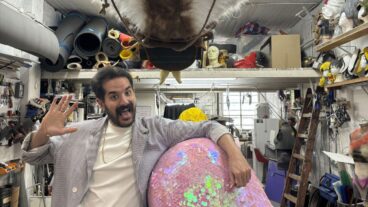It’s a stroller? It’s a bike? No, it’s the Taga! Able to transform into either one in seconds, it’s a healthy, green, inner-city transport solution for young families.
Urban parents are all too familiar with the hassles of driving and parking in the city. Whether it’s taking the kids to school or doing the daily round of errands, using a car isn’t good for the environment or your peace of mind.
A new Dutch-Israeli company called Taga has come up with a solution that environmentally conscious families will love. Last fall, the company rolled out its new hybrid stroller-bicycle which it dubbed the Taga.
Four years in the making, and perfectly matched to city life, in a matter of seconds the three-wheeler can be smoothly folded into a new shape. One minute it’s a comfortable bike with a child’s seat in the front, and the next it’s an attractive sturdy stroller. And the driver gets a health-enhancing workout while he or she enjoys the ride.
“A multifunctional urban vehicle for parents, not a bike or a stroller but a whole new concept,” is how Taga’s Hagai Barak describes this novel form of urban child transport, made chic.
After years of market research, the Taga is perfect for urban living, where people need to move from sidewalks to public transport to shops, with kids in tow, and where parking is scarce.
All the feedback is in the product
“It’s a product based on feedback from real parents who actually used it and it evolved over time,” Barak tells ISRAEL21c. “Every piece of feedback we received was integrated into the process.”
In other child ferrying solutions where the child is seated behind the rider or in a wagon, the drawbacks are not only safety concerns: “The fact that you don’t see the child and the child is behind you means you don’t enjoy the journey,” says Barak. Choosing the option where your child faces you, Taga “becomes a real experience and it protects the child better. It’s great fun, too,” smiles Barak.
With the Taga, one can choose to seat the child facing toward or away from the driver. And various accessories mean that two children can be transported, single file or facing each other. The Taga can also be converted into a bicycle for a teenager or a shopping bike.
A winner of a number of prestigious European cycling awards – including the King-Jugend Innovation Award 2008, the Eurobike award and the Red Dot Design Award 2009, Taga should be on sale in the US in 2010.
And expect it to be a good ride. Before developing it into a commercial product, the Taga team conducted a rigorous survey of parents from the US and Europe, to find out what they most want and need. Guided by responses, the Taga designers in Holland (where some of the major shareholders reside) and Israel meticulously designed the optimal newborn to teen transportation machine that has zero carbon emissions.
Forget the second car, buy a Taga
While at around $1,800 in the US and EU 1,800 in Europe it’s more than double the price of its most serious competitor, the Dutch Bugaboo, the Taga is built to last – from birth through a child’s teen years and beyond. It’s clearly an easy resell on sites like eBay or Craig’s List and is durable enough to be passed along to friends and relatives.
Barak says that in Europe some people are buying the Taga instead of a second car, and that in cities like New York it may replace the car altogether. So far, the Taga is available in 10 European countries, including France, Spain and the UK, where it can be bought in about 20 stores.
With no fuel costs, no parking fees, no carbon dioxide emissions and all the exercise you get while the kids are smiling, the company believes that the Taga will be a strong seller.
While it targets an upscale market, hopefully the Taga will inspire product designers to broaden the transport options for young urbanites.
With offices in Holland and Israel, Taga employs 14 people. Warehouses and logistics are run out of Israel, while the production facilities are based in Taiwan. Founded in 2005, its investors are from Holland and Belgium. “We were born global from day one,” says Barak.
For US customers who can’t wait until the beginning of 2010, direct orders can be placed through the company’s Dutch office with contacts on their website. Expect to pay the shipping costs.
Barak reveals that orders are already starting to come in from New York City.












